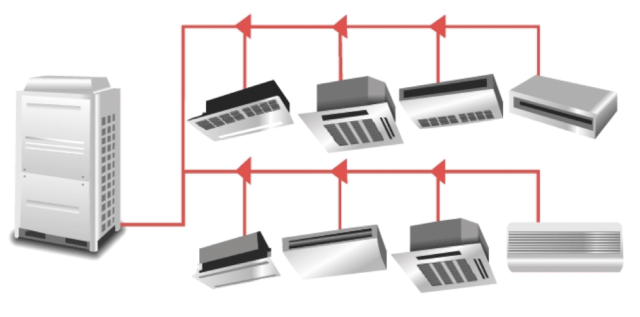Choosing the best heating and cooling system for your house or office building might be difficult. Split AC HVAC systems and VRF air conditioner (variable refrigerant flow) systems are alternatives for heating and cooling rooms without ducting.
You’ve therefore decided to install a ductless HVAC system in your commercial building. What comes after that? Two alternatives are primarily available to you. HVAC systems or VRF AC Systems. But what are the functions of these two systems. And how do they compare to one another? Let’s investigate!
A VRF Air Conditioner System: What Is It?
Systems that regulate temperature are known as variable refrigerant flow systems. An O’General VRF air conditioner system comprises heat exchangers located inside and outside the structure, similar to split HVAC systems. In contrast to the 1:1 ratio in conventional split systems, a single outside unit services several inside units in VRF systems. A distinct building zone is provided with temperature management by each inside unit. A branch selector control system can precisely control the refrigerant flow rate to each interior unit.
How Do VRF Air Conditioner Systems Function?
A working fluid or refrigerant is circulated between an evaporator in each indoor unit and a condenser in the outdoor unit throughout the refrigeration cycle that governs the operation of VRF air conditioner systems. These parts allow heat to be “pumped” from one air mass to another by exchanging heat with the refrigerant and the indoor/ambient air.
The refrigerant flow rate in the evaporators is changed to manage heat transfer at the interior units. Each inside unit can meet different heat loads simultaneously thanks to the O’General VRF AC branch selector’s ability to alter the flow rate.
Advantages Of VRF Air Conditioner Systems
The versatility of VRF system air conditioner systems is largely responsible for their advantages. They can simultaneously heat and cool several zones and offer a quick response to particular space heating/cooling requirements. Because of their capacity, these systems can transfer heat from one zone to another, increasing system effectiveness.
What Is HVAC?
Heating, ventilation, and air conditioning are referred to as HVAC. It encompasses the systems used in residential and commercial buildings, including offices, homes, and indoor stadiums, to regulate and distribute warm and cooled air. HVAC systems come in various configurations, but they all function similarly: they draw in the fresh air and use a mechanical ventilation system to heat or cool it to a specified temperature.
Using air cleaners that remove germs, spores, and virus-sized particles, HVAC devices can help regulate humidity levels and enhance air quality. You will be able to choose the ideal system and options for you and your home with the assistance of the HVAC specialist who visits your house for a pre-installation examination.
What Functions Do HVAC Systems Serve?
The most essential job of an HVAC system, according to the American Society of Heating, Refrigerating, and Air-Conditioning Engineers, is to bring air in, chill or heat it, and then blast it into a building. This space can be a single room, a house, a place of employment, an establishment, an airport, or even a submarine. One HVAC system component might serve two purposes. Your home may use a heat pump for both heating and cooling, or it may have a separate furnace and air conditioner.
Differences between HVAC And VRF Air Conditioners
Split air conditioning systems and VRF air conditioner (VRF) systems are both frequently used HVAC systems in commercial and residential buildings, but depending on your needs, one may be a better option than the other due to differences in cost, efficiency, cooling power, and installation.
Cost
Despite having a lot of cooling capacity, VRF air conditioner systems are significantly more expensive than split systems both at the time of purchase and during installation, and only really start to pay for themselves for very large spaces (like office buildings) with a floor area of between 10,000 and 80,000 square feet. Split systems can function admirably in somewhat larger rooms, although they are generally more cost-effective in smaller and medium-sized rooms. Split systems prevail in this case overall.
Cooling Ability
Since VRF air conditioner systems are typically designed for bigger commercial settings, they have an advantage in cooling power. They are also more adaptable because they can heat and cool multiple rooms simultaneously, while split systems typically can’t. Yet, such electricity is only economically viable in bigger areas.
Energy Savings
VRF systems are more effective than other types of systems overall. They are a more advanced technology created with power and efficiency in mind. However, using a VRF in a space smaller than 10,000 square feet is not cost-effective for energy savings; hence, efficiency is meaningless, and energy costs will increase without any discernible advantage. Overall, though, you should use VRF for efficiency.
Conclusion
The size of your building, the need to heat and cool simultaneously, and your budget will all influence the system you choose for new construction or an HVAC retrofit. Nonetheless, both programs operate flawlessly and use little energy. VRF and split AC systems equally deserve more examination. Whether you’re picking a system for a new construction project. Converting an older structure, or replacing an inefficient commercial HVAC system. For further information and a comprehensive quote, contact the O Generals team.

